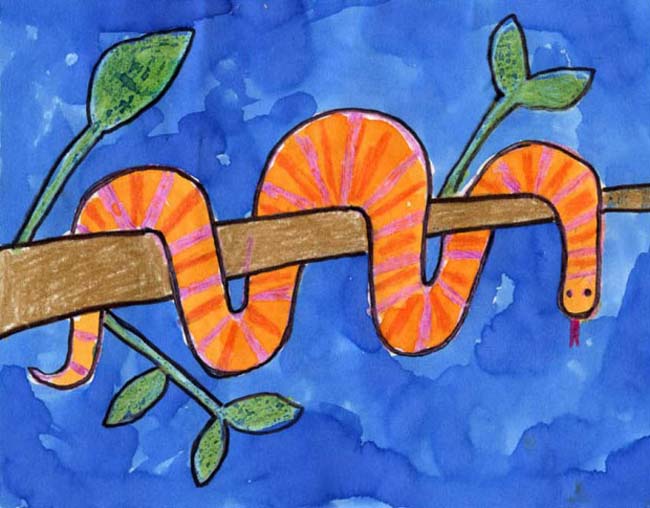The snake is almost always the bad guy. Voldemort’s Nagini in the Harry Potter series, Asmodeus Poisonteeth in Redwall, Cleopatra’s asp, and Satan in Milton’s “Paradise Lost” are all – well, pretty much evil. Kaa, the ancient python in Kipling’s Jungle Book, helps rescue Mowgli (the “man-cub”) from a band of hostile monkeys – but he also tries (several times) to eat him.
Still, to be fair, snakes can be adorable and cool. And they’re always interesting.
Table of Contents
SNAKE STORIES
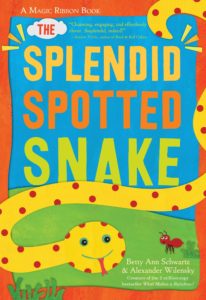 |
Colors! With a snake! In Alexander Wilensky’s The Splendid Spotted Snake (Workman Publishing, 2011), the cheerful snake – which, in the book, is made from a sturdy ribbon – is born with red spots, but as he grows, he gains more and more spots in sequentially different colors. For ages 2-5. |
| Also see Colors. | |
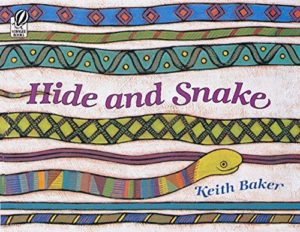 |
Keith Baker’s Hide and Snake (Houghton Mifflin Harcourt, 1995) is a gorgeously illustrated interactive picture book, in which readers try to find a colorfully patterned snake as it slithers from page to page, entangling itself in yarn, hats, baskets, cats, and shoelaces. For ages 2-6. |
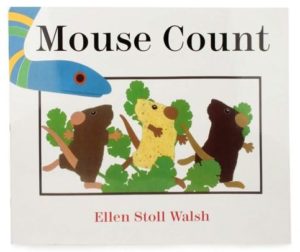 |
In Ellen Stoll Walsh’s Mouse Count (Houghton Mifflin Harcourt, 1995), a hungry snake decides to fill a jar with ten (charming) mice to take home for dinner. He counts them as he adds them, one by one, to the jar – but the mice cleverly manage to un-count themselves again and escape. An exercise in counting forward and backward for ages 2-6. |
| Mouse Count Activities has games, activities, and printables to accompany the book. (Make adorable sewn-paper mice.) | |
| More mouse resources! See Nice Mice and Awesome Rats. | |
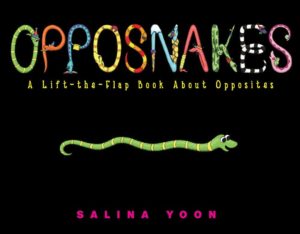 |
Salina Yoon’s Opposnakes (Little Simon, 2009) is an appealing lift-the-flap book about opposites, with snakes – which are variously clean and dirty, quiet and loud, hot and cold, straight and tangled, and more. For ages 3-6. |
| Also see Words, Word Play, and Grammar. | |
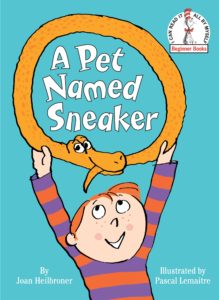 |
Joan Heilbroner’s A Pet Named Sneaker (Random House, 2013) is a delightful Beginner Book starring Sneaker, a pet-store snake who wants only to be adopted. Finally a little boy named Pete takes him home, and Sneaker proves to be a wonderful pet (and even a hero). For ages 4-7. |
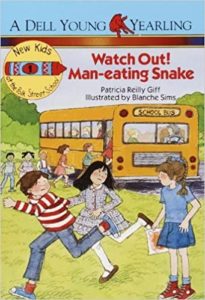 |
In Patricia Reilly Giff’s Watch Out! Man-Eating Snake! (Yearling, 1988) – one of the New Kids of Polk Street School series – it’s Stacy’s first day in kindergarten and she tries to make friends, but instead ends up terrifying everybody with her stories about her man-eating snake. (It’s really stuffed.) Luckily big sister Emily has some helpful advice about friendship. For ages 4-7. |
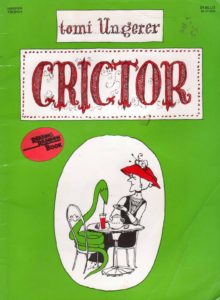 |
Tomi Ungerer’s Crictor (HarperCollins, 1983) is the story of a perfectly delightful boa constrictor sent as a birthday present to Madame Bodot by her son who studies reptiles in Africa. Soon Crictor charms the entire village. For ages 4-8. |
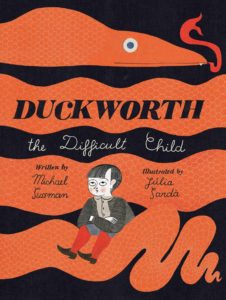 |
In Michael Sussman’s Duckworth the Difficult Child (Atheneum, 2019), Duckworth’s parents refuse to believe that a gigantic snake has crawled out of Duckworth’s closet. “It’s all in your head,” said Father. “It says here you will forget such nonsense if we give you chores to do. Please wash the dishes, Duckworth, and when you’re done with that, take out the garbage and mow the lawn.” For ages 4-8. |
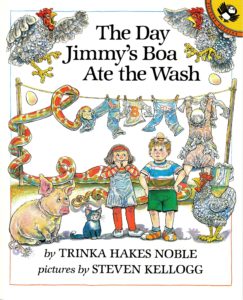 |
Trinka Hakes Noble’s The Day Jimmy’s Boa Ate the Wash (Puffin, 1992) is the riotous story of the disaster-laden day when Jimmy brings his pet boa constrictor on a class trip. With illustrations by Steven Kellogg. For ages 4-8. |
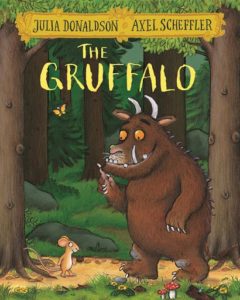 |
In Julia Donaldson’s The Gruffalo (Puffin, 2006), clever Mouse manages to scare off a hungry fox, owl, and snake by inventing a fearsome gruffalo (with terrible claws, terrible tusks, and terrible jaws). Mouse isn’t worried, because there’s no such thing as a gruffalo – until, to his horror, he actually encounters one. But it turns out that inventive Mouse has a story ready. For ages 4-8. |
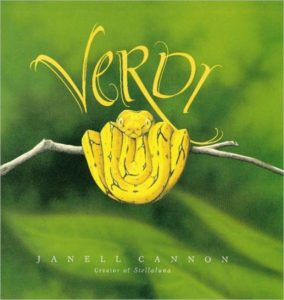 |
In Janell Cannon’s Verdi (Houghton Mifflin Harcourt, 1997), Verdi is a bright-yellow little python who is determined never to grow up to be “lazy, boring, or green!” When, to his horror, he discovers that he’s developing a green stripe, he does his very best to get rid of it, which nearly leads to disaster. Eventually Verdi comes to terms with adulthood, discovering that – even though he’s green – “I’m still me!” For ages 4-8. |
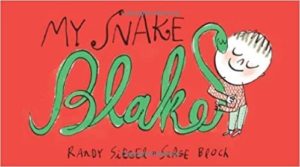 |
In Randy Siegel’s My Snake Blake (Roaring Brook Press, 2012), the protagonist gets a super-long, bright green snake for his birthday as a present from his dad. (“I think your father is nuts,” said my mom, as she walked in, frowning. “And proud of it,” answered dad. “Now let the snake out.”) Luckily Blake is a very talented snake, capable of spelling words with his coils. Like “RELAX.” Funny and terrific for ages 4 and on up. |
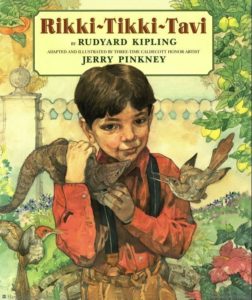 |
“Rikki-Tikki-Tavi,” which first appeared in Rudyard Kipling’s 1894 classic The Jungle Book, is the story of a brave little mongoose who saves a British family in India from Nag and Nagaina, a pair of deadly cobras. For a picture-book version of the tale, see Rikki-Tikki-Tavi (Morrow Junior Books, 1997), with illustrations by Jerry Pinkney. For ages 6 and up. |
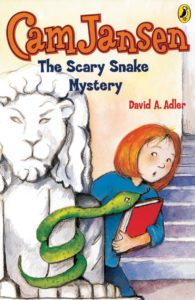 |
David Adler’s Cam Jansen: The Scary Snake Mystery (Puffin, 2005) stars young detective Cam Jansen, whose nickname (Cam is short for “Camera”) refers to her photographic memory. This one involves a loose snake and a stolen video camera. For ages 5-8. |
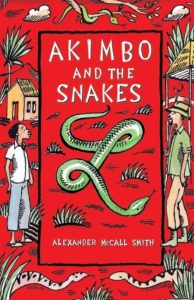 |
In Alexander McCall Smith’s Akimbo and the Snakes (Bloomsbury, 2006) – one of a series – ten-year-old Akimbo’s father is head ranger on a game preserve in Africa. In this book, Akimbo goes to visit his uncle’s snake farm, where he becomes involved in a hunt for a rare (and dangerous) green mamba. For ages 7-9. |
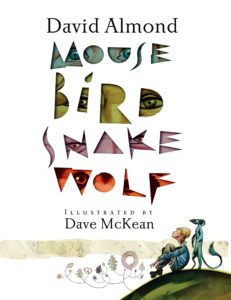 |
David Almond’s Mouse Bird Snake Wolf (Candlewick, 2013) is an original creation tale in which the gods – now back in the clouds, having naps and tea – have left gaps in the world. These are filled in by three imaginative children who conjure up a mouse, bird, snake, and finally a wolf. With the wolf, things get dangerous. A thought-provoking read for ages 7-10. |
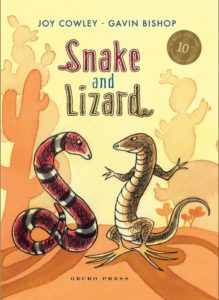 |
Joy Cowley’s Snake and Lizard (Kane/Miller Books, 2008) covers – in many short chapters – the adventures of two unlikely friends, laid-back Snake and excitable Lizard. For ages 7-10. |
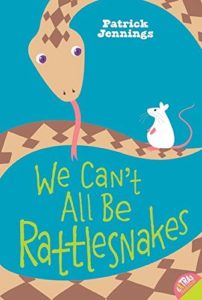 |
The narrator of Patrick Jenning’s We Can’t All Be Rattlesnakes (HarperCollins, 2011) is Crusher, a gopher snake, captured by “an oily, filthy, fleshy human child” named Gunnar. (“Gunnar thinks I’ll be his adoring pet. He’s wrong.”) Snarky Crusher decides to pretend to be tame while plotting to escape, but soon finds herself feeling sorry for clueless Gunnar. Clever, funny, and a great animal voice. For ages 8-12. |
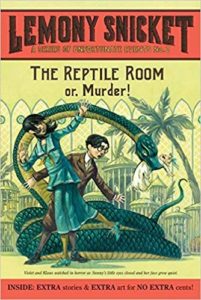 |
In The Reptile Room (HarperCollins, 2007) – Book 2 of Lemony Snicket’s A Series of Unfortunate Events series – the luckless Baudelaire orphans are living with their herpetologist Uncle Monty, owner of the Incredibly Deadly Viper. Hilariously miserable for ages 8-12. |
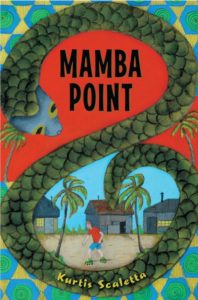 |
In Kurtis Scaletta’s Mamba Point (Yearling, 2011), 12-year-old Linus moves to Liberia where his father has a job at the American embassy. Linus is terrified of deadly black mambas – but somehow mambas seem to be drawn to Linus. It turns out that Linus is a kaseng – a person with a mysterious connection to certain animals, in his case, mambas. Soon he has adopted a mamba as a pet – and with the help of the snake, he eventually becomes what he wants to be: “a whole new Linus.” For ages 8-12. |
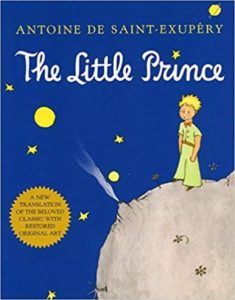 |
Antoine de Saint-Exupery’s The Little Prince (Houghton Mifflin Harcourt, 2013), originally published in 1943, is the poetic and philosophical tale of an aviator who, as a child, drew a picture of an elephant that had been swallowed by a boa constrictor – but which all the adults around him said was a hat. Now an adult, the aviator is stranded in the desert, attempting to repair his plane, when he meets the mysterious little prince – here from his tiny distant home planet. For starts, the little prince knows the picture is of an elephant inside a snake. A wonderful story. Readers will find a lot to talk about. For ages 10 and up. |
| From the Teaching Children Philosophy website, The Little Prince has a long list of creative discussion questions. | |
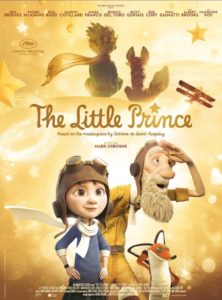 |
The 1974 film version of The Little Prince, in which Bob Fosse plays a superb Snake, is rated G. There’s also an animated version (2015), a sequel, in which a little girl is introduced to the world of the Little Prince by the Aviator. Rated PG. |
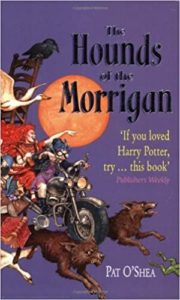 |
In Pat O’Shea’s The Hounds of the Morrigan (HarperTeen, 1999), ten-year-old Pidge and his little sister Brigit find a book in a second-hand bookshop that turns out to be an ancient prison for the powerful and evil serpent Olc-Glas. The Morrigan – goddess of death and destruction – wants to use the serpent’s power to take over the world, and the children soon find that they’re involved in a great battle between the forces of good and evil. This is a wonderful fantasy, filled with characters and images from Celtic mythology. It’s available through libraries and from used-book dealers. For fans of Tolkien and C.S. Lewis, this one is well worth tracking down. Highly recommended for ages 11 and up. |
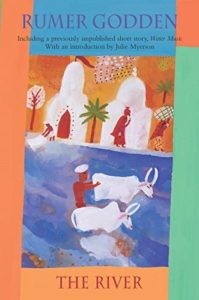 |
Rumer Godden’s The River (Trans-Atlantic Books, 2004) is the story of Harriet, who lives with her British family in India. There Harriet, a would-be poet, struggles with change and relationships – with her older sister, Bea; the wounded soldier, Captain John; and her little brother, who is fascinated with the cobra in the garden. A thoughtful and beautiful exploration of life and death, love, loss, and growing up. For ages 12 and up. |
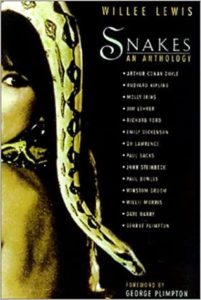 |
Collected by Willee Lewis, Snakes: An Anthology of Serpent Tales (M. Evans & Company, 2003) is a compendium of stories, poems, and first-person encounters with snakes, with contributions from Sir Arthur Conan Doyle, Emily Dickinson, Rudyard Kipling, Roald Dahl, Zora Neale Hurston, and Mark Twain. For ages 13 and up. |
| From Sir Arthur Conan Doyle’s The Adventures of Sherlock Holmes, “The Speckled Band” (spoiler!) involves a snake. Read it online here. | |
| From the Brothers Grimm, “The White Snake” centers around a magical (and apparently cooked) white snake that gives people the power to understand the language of animals. Read it online here. | |
| From The Guardian, check out this list of the Ten Best Snakes in Literature. | |
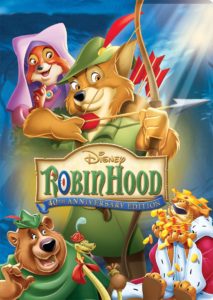 |
In the Disney version of Robin Hood (1973), all the characters are animated – including Sir Hiss, wicked Prince John’s wicked snake sidekick. (Robin and Maid Marian are foxes.) Rated G. |
